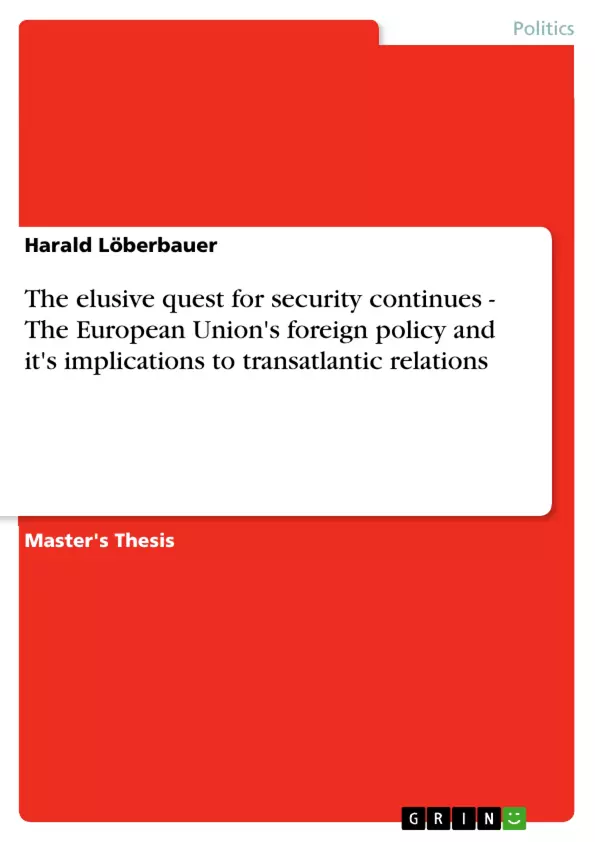The title of this analysis is based on a book by Simon Duke dealing with the theoretical implications of a common European foreign policy in security and defense matters. The content of the book differs from the content of this paper and is not related to the questions posed in this research.1
Part II of this research gives a detailed overview of what security actually means in global politics and how key players understand it. General definitions and theory allows us to understand the major parts of this thesis (part III and IV). Part III describes different approaches to security in IR theory and explains it on the basis of European political integration. The historio-political analysis in this part shows the evolution of a CFSP and the ESDP. Institutionalization processes within the European Union explain the current status of the EU’s foreign policy, which is a status in process without having a clear and defined goal. This part includes the legal dimension of the EU’s foreign policy as well and describes the problematic situation Europeans currently have to face, namely disputes about the legal personality of the European Community and the European Union. Part IV is the second major part of the paper and deals with security challenges and the impact of the EU’s foreign policy on transatlantic relations and/or vice versa. This part has a closer look on the practical side of what the European Union is able and willing to do as a key player in the political, security and military domain in the world. It shows the relations between Europe and the United States and gives a segmentary analysis of Europe’s power in global politics...
...This research identifies the following specific hypotheses subordinated to the main hypotheses:
1.The European Union will become a global key player in the political and military domain, but will remain at the lower end of high politics for a while (ESDP police missions and military operations).
2.Transatlantic relations in the form of the Atlantic Alliance (or extended atlantic alliance) will remain of essential importance in order to achieve the EU’s foreign policy goals.
3.Cooperation in the military domain with the United States will remain the only way for Europe during the process of building up a European military.
Inhaltsverzeichnis (Table of Contents)
- I Introduction
- 1.1 Object of research and structure
- 1.2 Main questions
- 1.3 Method
- II General definitions and theory
- 2.1 Security and the concept of the state
- 2.2 The international state system
- 2.3 Global and regional institutions in the security domain
- 2.4 Security strategies
- 2.5 Security and integration: the political idea of a community
- III The elusive quest for security in Europe
- 3.1 Realist and liberal conceptions of security
- 3.1.1 A realist rationality
- 3.1.2 A liberal argument in a post Cold War era
- 3.1.3 The theory of supranationalism and intergovernmentalism
- 3.2 Towards a European cooperation in political matters
- 3.2.1 From EPC to a CFSP
- 3.2.2 From Maastricht to Nice
- 3.3 Institutionalization processes
- 3.3.1 Major motivation for a CFSP
- 3.3.2 A European Common Foreign and Security Policy
- 3.3.3 The structure of the CFSP and the legal background
- 3.3.4 Development and evolution of the ESDP
- 3.4 The legal framework of the EU – legal personality disputes
- IV Security challenges and transatlantic relations
- 4.1 CFSP’s structural (institutional) deficits
- 4.2 Transatlantic relations and security approaches
- 4.3 European defense: a vain endeavor?
- 4.4 The European Union as a global actor – ESDP missions
- 4.5 Regional or global power? A segmentary analysis
Zielsetzung und Themenschwerpunkte (Objectives and Key Themes)
This master's thesis examines the development of the European Union's foreign policy, focusing on its implications for transatlantic relations. The central hypothesis is that the EU is in the process of developing a significant foreign policy, but its success depends heavily on continued cooperation with the United States.
- The definition and evolution of security in international relations theory.
- The role of realist and liberal perspectives on security in shaping European integration.
- The development and institutionalization of the Common Foreign and Security Policy (CFSP) and the European Security and Defence Policy (ESDP).
- The impact of the EU's foreign policy on transatlantic relations, and vice-versa.
- An assessment of the EU's potential to become a major global player in security and defense.
Zusammenfassung der Kapitel (Chapter Summaries)
Chapter I: Introduction introduces the research question and methodology, outlining the structure and key questions addressed in the thesis.
Chapter II: General definitions and theory provides foundational definitions of key concepts, such as security, the state, and the international state system. It also explores various security strategies, including collective security, collective defense, and cooperative security, and their relationship to European integration.
Chapter III: The elusive quest for security in Europe examines the development of European security cooperation, tracing the evolution from the European Political Cooperation (EPC) to the CFSP and ESDP. It explores realist and liberal perspectives on security in the European context, and analyzes the interplay of supranational and intergovernmental approaches to European integration.
Chapter IV: Security challenges and transatlantic relations analyzes the structural deficits within the CFSP and their impact on transatlantic relations. It discusses differing security approaches between the EU and the US, particularly regarding preemptive and preventive strategies. The chapter also examines the EU's role in ESDP missions and operations, and evaluates the EU's potential to become a global power.
Schlüsselwörter (Keywords)
The key terms and concepts explored in this thesis include: European Union foreign policy, Common Foreign and Security Policy (CFSP), European Security and Defence Policy (ESDP), transatlantic relations, security, realism, liberalism, supranationalism, intergovernmentalism, globalization of production (GoP), power, and military capabilities.
- Citation du texte
- Harald Löberbauer (Auteur), 2007, The elusive quest for security continues - The European Union's foreign policy and it's implications to transatlantic relations, Munich, GRIN Verlag, https://www.grin.com/document/122176



